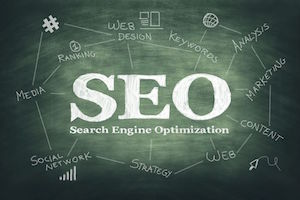SEO’s Role in an Integrated Campaign
In a successful integrated digital campaign, SEO plays a large role in delivering a solid ROI. Now, I may be biased, as I am the Search Marketing Architect for Blueprint, but repeated studies show that an organic #1 listing captures 33% of all clicks, whereas other channels of digital marketing have much lower click through rates (mostly single digits).
However, successful SEO campaigns take time. Any tactic meant to “win immediately” in natural results is likely black hat and will result in a penalty further down the road. Many businesses need the phone to ring immediately, which is where paid search and social PPC can thrive. But just remember that with paid advertising, you’re always paying for the leads. Meanwhile, SEO can build and attract the largest number of consumers, many of which are actively searching for your products and/or services.
So while using white hat and best practices to conduct your SEO campaign, what role should search marketing play when interacting with the other channels of site design, PPC, and social?
SEO & UX: Information Architecture
At Blueprint, our SEO team is extremely lucky to have a production team in-house that works together on site builds. Why does this make us lucky? Because it means our site builds are optimization ready, and more importantly, we’re consulted when building the site map. How a site and its content is structured is important for consumers and search engines alike to understand what your site is about.
For example, a software company website that just has “Products” in the top nav with a dropdown of their copyrighted product names. Unless that company has spent quite a bit of effort and money into branding those products, can users really understand what the solution is and why it’s relevant? Not likely. This is where having SEO input on the site map before building the site is beneficial. The site will already be set up for optimization.
Other items where an SEO perspective is helpful are:
- Breadcrumb URL structure
- Sacrificing “cool” features in favor of more tried-and-true methods, plus better page speed
- Custom 404 page
- Footer content
SEO & PPC: Share the Data and Content
PPC is completely conversion driven and lives at the bottom of the funnel in Acquisition. This means that while PPC has their own landing pages and conversion data, the SEO team should be examining that information to better understand the motivations behind particular keywords. For example, which keywords are resulting in more sales vs. just looking for information? Understanding these differences in how people search based on where they are in the buying funnel can drastically change how SEO presents its own content and defines success.

Many successful PPC campaigns use content incentives to encourage lead generation. These may be whitepaper downloads and offers for a free consultation or report. If your paid channels are using these, are there certain content types or topics that are more successful than others? From those, the SEO team can better understand the content concepts that consumers are curious about, and thus, tailor content to discuss them. SEO is entirely about answering the questions consumers are asking and in the way they expect to be answered.
The content flow should also go both ways. Has the SEO team created a fantastic blog series on comparing products? Consider putting these blogs together in a great whitepaper that the PPC team can then offer on their landing pages for greater conversions.
SEO & Social: Promotion & Gaining Insight to the Community
When discussing blogging as a marketing tool, it’s brought up in SEO circles just as much as it is in social. At Blueprint, we offer blogging as one of our SEO services in order to support particular landing pages. However, we also feel it’s vital to have active social media marketing to promote the new content as it goes live on your site. (Of course there are many benefits to having solid social media marketing, but I’ll leave that to Jeff A., our Social Architect.)
Similar to getting data from PPC to understand the consumer better, the social community is arguably the best place for learning the biggest pain points for your consumers, as well as their most common questions. So what does that mean for SEO? Create content around these! If you’re able to identify the biggest pain points of your consumers and then tell them how you ease that pain, you’re much more likely to first gain their attention, and then the lead! Similarly, if five or twenty people have asked the question on your Facebook page, maybe it’s time to consider publishing content that answers those questions. Today’s consumer is used to information overload and doesn’t want to have to work to find answers.
The best digital campaigns are those that are truly integrated. While SEO can certainly make a huge impact on its own, consider complimenting search marketing with other digital marketing channels to jumpstart your business and gain powerful data that’ll only make your campaigns more effective.



